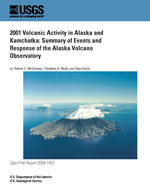Pavlof 2001/1
Start: January 20, 2001 [1]
Stop: December 13, 2001 [1]
Event Type: Not an eruption
- Fumarolic or hydrothermal activity [1]
- Steam [1]
Description: McGimsey and others (2004) summarize 2001 steaming and other activity at Pavlof as follows: "Principal/Teacher, John Concilius, has a good view of Pavlof from his home in Nelson Lagoon. On January 20, 2001 he observed through binoculars steaming from multiple locations near the summit, but none actually at the top of the volcano. He reported that the steam was white and not discolored, and, that the snow near the summit was clean with no evidence of melting.
"He concluded by stating that this was the most steaming he had seen at the volcano during the past several years and that other villagers considered the steaming to be unusual.AVO remote sensing specialist Dave Schneider analyzed Advanced Very High Resolution Radiometer (AVHRR) satellite images taken from January 18 to 22, 2001 and found no evidence of increased thermal activity at the volcano and no unusual seismicity was noted. No further reports of steaming were forthcoming. This may have been a meteorological phenomenon.While working in Cold Bay in early June, Martin LaFevers, Seismic Data Manager at UAFGI, observed and photographed the summit of Pavlof during a weather break; it appeared to be covered with ash. A local pilot reported seeing 'something other than steam' at the summit. Again, there was no indication of anomalous seismicity.
"NWS observers in Cold Bay contacted AVO on the morning of November 7, 2001 to report a small steam plume originating from the south side of Pavlof; they also received several Pilot Weather Reports (PIREPS) describing the same observation. About a month later, on December 13, 2001, NWS personnel in Cold Bay reported steam issuing from a point about half-way down the south flank of the volcano. The plume rose to a height of about 6,000 ft (~1,830 m) before dissipating. A Pen Air pilot corroborated the report and added that the steaming was coming from a 'hill' on the southwest flank; this pilot added that he encountered a strong sulfur smell on a flight by the volcano that day. AVO detected no unusual seismicity or thermal anomalies. Based on conversations with the Pen Air pilot, AVO determined that the source of steaming was likely the fumarole field on nearby Mt. Hague, a late Pleistocene volcano with no historic activity."
"He concluded by stating that this was the most steaming he had seen at the volcano during the past several years and that other villagers considered the steaming to be unusual.AVO remote sensing specialist Dave Schneider analyzed Advanced Very High Resolution Radiometer (AVHRR) satellite images taken from January 18 to 22, 2001 and found no evidence of increased thermal activity at the volcano and no unusual seismicity was noted. No further reports of steaming were forthcoming. This may have been a meteorological phenomenon.While working in Cold Bay in early June, Martin LaFevers, Seismic Data Manager at UAFGI, observed and photographed the summit of Pavlof during a weather break; it appeared to be covered with ash. A local pilot reported seeing 'something other than steam' at the summit. Again, there was no indication of anomalous seismicity.
"NWS observers in Cold Bay contacted AVO on the morning of November 7, 2001 to report a small steam plume originating from the south side of Pavlof; they also received several Pilot Weather Reports (PIREPS) describing the same observation. About a month later, on December 13, 2001, NWS personnel in Cold Bay reported steam issuing from a point about half-way down the south flank of the volcano. The plume rose to a height of about 6,000 ft (~1,830 m) before dissipating. A Pen Air pilot corroborated the report and added that the steaming was coming from a 'hill' on the southwest flank; this pilot added that he encountered a strong sulfur smell on a flight by the volcano that day. AVO detected no unusual seismicity or thermal anomalies. Based on conversations with the Pen Air pilot, AVO determined that the source of steaming was likely the fumarole field on nearby Mt. Hague, a late Pleistocene volcano with no historic activity."
References Cited
[1] 2001 volcanic activity in Alaska and Kamchatka: Summary of events and response of the Alaska Volcano Observatory, 2004
McGimsey, R.G., Neal, C.A., and Girina, Olga, 2004: 2001 volcanic activity in Alaska and Kamchatka: Summary of events and response of the Alaska Volcano Observatory: U.S. Geological Survey Open-File Report 2004-1453, 53 p.Complete Eruption References
2001 volcanic activity in Alaska and Kamchatka: Summary of events and response of the Alaska Volcano Observatory, 2004
McGimsey, R.G., Neal, C.A., and Girina, Olga, 2004: 2001 volcanic activity in Alaska and Kamchatka: Summary of events and response of the Alaska Volcano Observatory: U.S. Geological Survey Open-File Report 2004-1453, 53 p.
